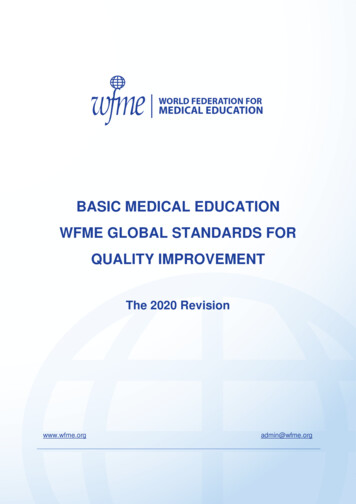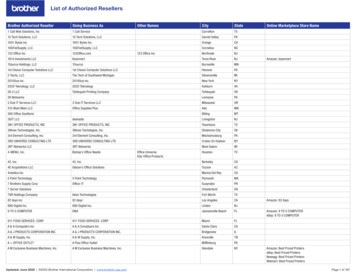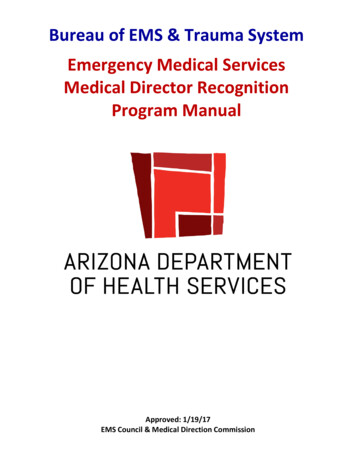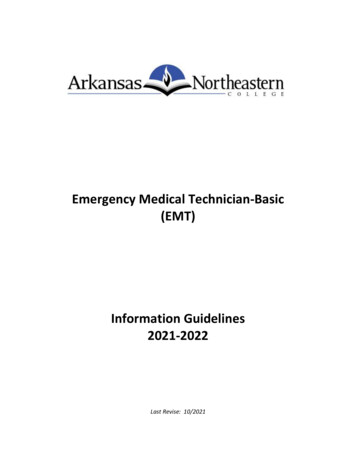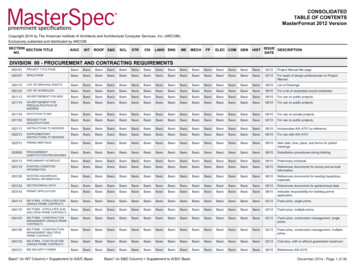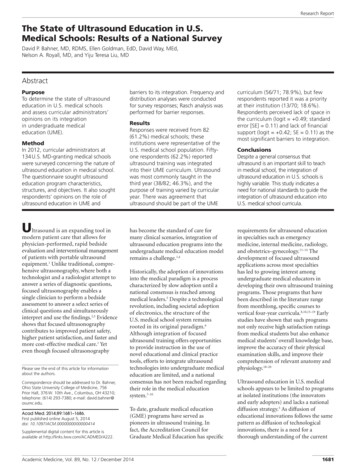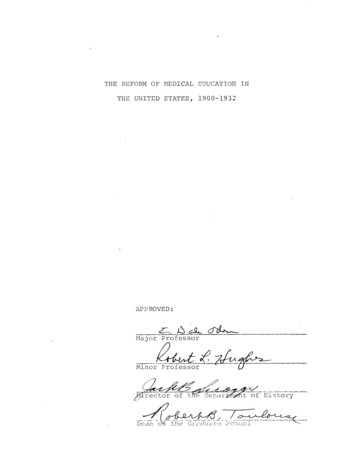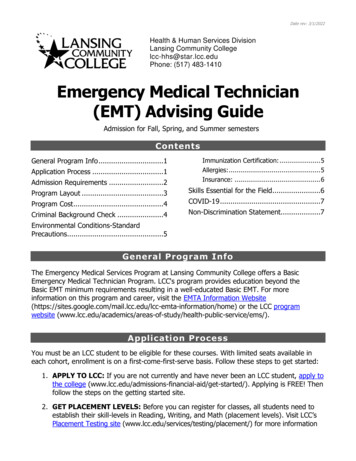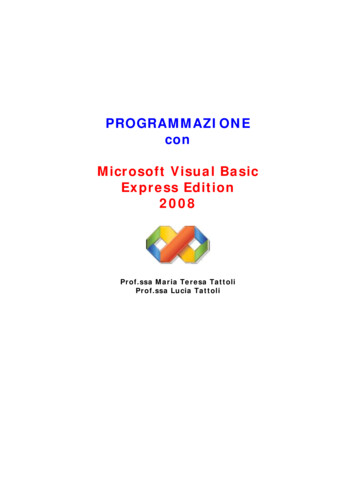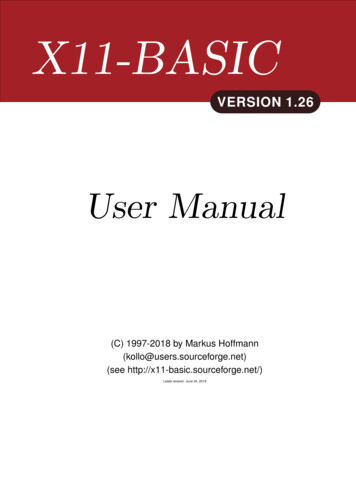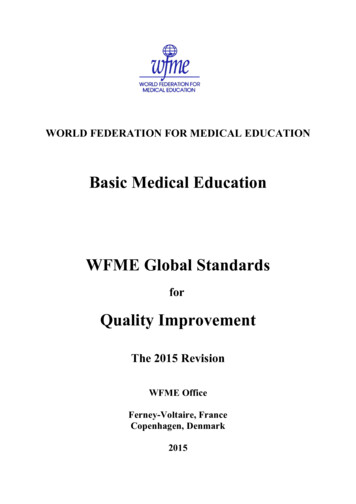
Transcription
WORLD FEDERATION FOR MEDICAL EDUCATIONBasic Medical EducationWFME Global StandardsforQuality ImprovementThe 2015 RevisionWFME OfficeFerney-Voltaire, FranceCopenhagen, Denmark2015
2
CONTENTSPREFACEINTRODUCTION79HISTORY9FUNDAMENTALS OF BASIC MEDICAL EDUCATION (BME)11VALUE OF GLOBAL STANDARDS11PREMISES FOR STANDARDS IN BASIC MEDICAL EDUCATION12USE OF STANDARDS14PROCESS AND PRINCIPLES OF REVISIONTHE WFME GLOBAL STANDARDS FOR QUALITYIMPROVEMENT OF BASIC MEDICAL RDS17ANNOTATIONS18THE STANDARDS181. MISSION AND OUTCOMES191.1 MISSION191.2 INSTITUTIONAL AUTONOMY AND ACADEMIC FREEDOM201.3 EDUCATIONAL OUTCOMES211.4 PARTICIPATION IN FORMULATION OF MISSION AND OUTCOMES222. EDUCATIONAL PROGRAMME232.1 FRAMEWORK OF THE PROGRAMME232.2 SCIENTIFIC METHOD232.3 BASIC BIOMEDICAL SCIENCES242.4 BEHAVIOURAL AND SOCIAL SCIENCES, MEDICAL ETHICSAND JURISPRUDENCE242.5 CLINICAL SCIENCES AND SKILLS252.6 PROGRAMME STRUCTURE, COMPOSITION AND DURATION262.7 PROGRAMME MANAGEMENT272.8 LINKAGE WITH MEDICAL PRACTICE AND THE HEALTHSECTOR273. ASSESSMENT OF STUDENTS293.1 ASSESSMENT METHODS293
3.2 RELATION BETWEEN ASSESSMENT AND LEARNING4. STUDENTS314.1 ADMISSION POLICY AND SELECTION314.2 STUDENT INTAKE314.3 STUDENT COUNSELLING AND SUPPORT324.4 STUDENT REPRESENTATION335. ACADEMIC STAFF/FACULTY355.1 RECRUITMENT AND SELECTION POLICY355.2 STAFF ACTIVITY AND STAFF DEVELOPMENT366. EDUCATIONAL RESOURCES376.1 PHYSICAL FACILITIES376.2 CLINICAL TRAINING RESOURCES376.3 INFORMATION TECHNOLOGY386.4 MEDICAL RESEARCH AND SCHOLARSHIP386.5 EDUCATIONAL EXPERTISE396.6 EDUCATIONAL EXCHANGES407. PROGRAMME EVALUATION417.1 MECHANISMS FOR PROGRAMME MONITORING ANDEVALUATION417.2 TEACHER AND STUDENT FEEDBACK427.3 PERFORMANCE OF STUDENTS AND GRADUATES427.4 INVOLVEMENT OF STAKEHOLDERS438. GOVERNANCE AND ADMINISTRATION458.1 GOVERNANCE458.2 ACADEMIC LEADERSHIP458.3 EDUCATIONAL BUDGET AND RESOURCE ALLOCATION468.4 ADMINISTRATION AND MANAGEMENT468.5 INTERACTION WITH HEALTH SECTOR479. CONTINUOUS RENEWAL49429
BIBLIOGRAPHY51PREVIOUS AND PRESENT WFME STANDARDS51GENERAL52BME-RELATED55APPENDIX: MEMBERS OF TASK FORCE57WORKING PARTY57INTERNATIONAL PANEL OF EXPERTS58WFME EXECUTIVE COUNCIL635
6
PREFACEStarting in 1998, the World Federation for Medical Education (WFME) developed the WFMETrilogy: Global Standards for Quality Improvement of Medical Education, covering all threephases of medical education: Basic (Undergraduate) Medical Education (BME);Postgraduate Medical Education (PME); and Continuing Professional Development (CPD) ofMedical Doctors. Preliminary results were presented in 2000 and the Trilogy was published in2003.The global standards for medical education have been implemented and used extensively allover the world. They offer medical education institutions and programmes at various stages ofdevelopment, and with different educational, socio-economic and cultural conditions anddifferent disease patterns, a template for defining institutional, national and regionalstandards, and a lever for reform programmes.As a result, valuable experience was gained and fruitful advice and recommendationscompiled from the use of the standards in institutional and national medical educationreforms, evaluation and accreditation procedures.From the outset it was decided that the global standards should not be changed too frequentlywith the risk of creating unnecessary inconvenience among user institutions. However, tenyears after publication of the global standards for medical education, the Executive Council ofWFME realised the need for a revision taking into account the commentaries received frommedical educators, institutions and organisations and the accumulated relevant literature in thefield. Therefore, in 2012 the Federation initiated a revision of the Trilogy.During the revision process, which involved a small working party and a broad internationalpanel of experts, extensive comments and proposals were received, showing a need for athorough overhaul. The first revision of standards for basic medical education was publishedin 2012. However, due to the aim of obtaining reasonable harmonisation between the threedocuments of the WFME Trilogy, and taking into account later received proposals, it wasfound necessary to produce the present updated edition of the revised document for basicmedical education; this revision comprises foremost the introduction and sections ofannotations to the standards, whereas the standards themselves have only undergone limitedchanges. It should also be emphasised that this revised version of the WFME standards forbasic medical education respects the original overall principles and structure. The revisedversion presents much the same standards at two levels of attainment, basic anddevelopmental, as the original 2003 standards document.WFME is profoundly indebted to all who have contributed to the process of reviewing theglobal standards. The enthusiasm and readiness to assist encountered in all regions have beenoverwhelming, thereby signalling that the standards are both desirable and feasible.The WFME Executive Council trusts that the revised standards document will be useful foreverybody involved in basic medical education. The document will be of interest for healthauthorities, medical associations, medical schools and national and internationalinstitutions/organisations dealing with basic medical education in all countries. WFME wouldadvise that trustworthy authorities are established country-wise to oversee the application ofthe global BME standards.7
8
INTRODUCTIONHISTORYThe improved health of all peoples is the main goal of medical education. This is also theoverall mission of the World Federation for Medical Education (WFME), the internationalbody representing all medical teaching institutions, medical teachers and students and medicaldoctors in all aspects of their education. In keeping with its constitution, WFME undertakes topromote the highest scientific and ethical standards in medical education, and to encouragedevelopment of learning methods, new instructional tools, and innovative management ofmedical education.Since 1984, WFME has conducted an "International Collaborative Programme for theReorientation of Medical Education". Cornerstones in this process were the EdinburghDeclaration, 1988, which was adopted by the World Health Assembly, WHA Resolution42.38, 1989, and the Recommendations of the World Summit on Medical Education, 1993,reflected in WHA Resolution 48.8, Reorientation of Medical Education and Medical Practicefor Health for All, 1995.In compliance with its mandate, WFME launched the programme on global standards inMedical Education in a position paper of 1998. The purpose was to provide a tool for qualityimprovement of medical education, in a global context, to be applied by institutionsresponsible for medical education, and in programmes throughout the continuum of medicaleducation.The WFME programme on global standards in medical education, approved by the WorldHealth Organization (WHO) and the World Medical Association (WMA), had from the veryoutset three main intentions: to stimulate authorities, organisations and institutions having responsibility formedical education to formulate their own plans for change and for qualityimprovement in accordance with international recommendations; to establish a system of national and/or international evaluation, accreditation andrecognition of medical educational institutions and programmes to assure minimumquality standards for the programmes; and to safeguard practice in medicine and medical manpower utilisation, in the context ofincreasing internationalisation, by well-defined international standards in medicaleducation.The WFME global standards embrace all phases of medical education, i.e. basic(undergraduate) medical education, postgraduate medical education and continuingprofessional development of medical doctors. The trilogy of global standards intends tofacilitate the relationship between the stages of medical education.In developing the Trilogy, WFME appointed three International Task Forces, each comprisinga Working Party meeting on a retreat basis, and a broader Panel of Experts that communicated9
mainly electronically. Members of the Task Forces were selected on basis of their expertiseand with geographical coverage an important consideration. The drafts of the standardsdocuments were discussed frequently and in numerous settings around the world. The manycommentaries received were collated and taken into account.Implementation around the world of the standards programme started immediately after thefirst presentation in 2000 and the conduct of pilot studies in all 6 WFME Regions. Theprocess of implementation was accelerated after broad international endorsement of thestandards at the WFME World Conference Global Standards in Medical Education for BetterHealth Care in Copenhagen 2003.The global standards, translated into several languages, have been used and have influencednational planning of medical education in many countries.In the early stages of developing the global standards for medical education, it became clearthat specifying global standards in any restricted sense would exert insufficient impact andwould have the potential to lower the quality of medical education. The criticism, whetherjustified or not, has become commonplace that medical education has adjusted slowly andinadequately both to changing conditions in the health care delivery systems, and to the needsand expectations of societies. Thus, a lever for change and reform was incorporated into thestandards. This led the WFME standards to being framed to specify attainment at twodifferent levels: (a) basic standards or minimum requirements; and (b) standards for qualitydevelopment.That the WFME standards would have the status as an accreditation instrument wasconsidered from the inception. After deliberation, WFME has taken the position that onlynationally appointed agencies can be directly responsible for accreditation procedures.However, WFME can have a role in assisting in accreditation processes and globally adoptedstandards can function as a template for the agencies designated to implement evaluation andaccreditation. WFME, in collaboration with WHO, developed guidelines and procedures foraccreditation as an activity within the WHO/WFME Partnership of 2004 to improve medicaleducation.The medical workforce is globally mobile and the WFME standards have a part to play insafeguarding adequate educational grounding of migrating doctors. However, incentives forretaining locally trained doctors in their own countries and regions are equally essential. TheWFME standards should not be viewed as encouraging increasing medical mobility andspurring brain drain of doctors from developing countries. The world is characterised byincreasing internationalisation, from which the medical workforce is not immune, andcompliance with the standards should serve as necessary quality-assuring credentials ofmedical doctors wherever they are based.To ensure that the competencies of medical doctors are globally applicable and transferable,readily accessible and transparent documentation of the levels of quality of educationalinstitutions and their programmes is essential. The Avicenna Directory of Medical Schools,developed by WFME from 2007 to replace the WHO World Directory of Medical Schools,aimed to constitute a roster of medical educational institutions, indicating specifically whetherinstitutions included have attained globally approved standards for medical educationprogrammes. The New World Directory of Medical Schools, established in 2012 as a mergerof the Avicenna Directory and the International Medical Education Directory (IMED) of the10
Foundation for the Advancement of International Medical Education and Research(FAIMER) has continued this line.FUNDAMENTALS OF BASIC MEDICAL EDUCATION (BME)The basis of the medical curriculum consists of the fundamental theory and practice ofmedicine, specifically basic biomedical, behavioural and social sciences, clinical sciences andgeneral clinical skills, including clinical decision skills, communication abilities,interprofessional collaboration, doctors’ function in the society and medical ethics. This basismust be addressed by all medical schools aiming to produce safe practitioners of quality.These elements have an important bearing on the concept of global standards in medicaleducation, but such standards do not address details regarding content and quantity. A globalset of standards for medical education is not to be equated with a universal core curriculum.Several reports have described the necessity for radical changes and innovations in thestructure and process of medical education at all levels. Such reconstruction is essential to: prepare doctors for the needs and expectations of society;cope with the explosion in medical scientific knowledge and technology;inculcate ability for life-long learning;ensure training in the new information technologies;adjust medical education to changing conditions in the health care delivery system.WHO has also advocated the need for change in medical education. It has proposed a series ofactivities intended to meet the current and future requirements of society, especiallyunderlining the importance of understanding the doctors’ function in the society, and the needfor continuing education and for inter-professional collaboration.Although accreditation is seen as the golden procedure in evaluating and assuring the qualityof medical education programmes, only a minority of the more than 2500 medical schoolsworldwide are subject to external evaluation and accreditation procedures. Such omissioncauses major concern when the imperative for reform is amply documented. The rapidincrease in the number of new medical schools in the last decades, many established onunacceptable grounds (e.g. some private »for profit« schools), adds to the disquiet.VALUE OF GLOBAL STANDARDSA central part of the WFME strategy is to develop global standards and guidelines for medicaleducation, that are supportive of the institutions concerned, their educational programmes, themedical profession, and the individual student and doctor. The global standards constitute aframework, serving as a yardstick against which those responsible for basic medical educationcan evaluate their own activities and organisations. Moreover, globally accepted standardscould be used as a basis for national and regional approval and accreditation of educationalprogrammes.Equally relevant for global standards is the process of medical education. Desirable practicesin educating the basic doctor, incorporating well-recognised and accepted principles of11
learning, together with the institutional conditions for educational activities, must form thebasis for global standards.Moreover, quality assurance of medical education must emphasise the need for improvementand provide guidance for achieving it. This will avoid interpretation of standards as a levellingat a lower level of quality among institutions.Standards are not an »either/or« matter, but a matter of specific conduct and intentionalplanning. Furthermore, some schools might develop so unique a quality as to go beyondstandards achieved by most medical schools. Such qualities might, in the long run, serve asexamples for new goal-settings in medical schools.Standards must be clearly defined, and be meaningful, appropriate, relevant, measurable,achievable and accepted by the users. They must have implications for practice, acknowledgediversity and foster adequate development.Evaluation based on generally accepted standards is an important incentive for improvementand for raising the quality of medical education, both when reorientation and reform arepursued, and also when continuous development is strived for.WFME considers that the operation of standards can promote discussion and stimulatedevelopment of consensus about objectives, and will help schools to formulate essentials oftheir educational programmes and to describe the fundamentals of medical education.Standards will broaden opportunities for educational research and development and fosterdiscussion and cooperation across departmental and other boundaries.The existence of standards will empower educators in their effort to bring about change, andwill serve to guide medical students’ choices.For curriculum planners, acceptance of standards will save time and resources. Adoption ofstandards for evaluation will provide valuable information for providers of funds, politiciansand society.Placing medical education on a basis of shared global standards will facilitate exchange ofmedical students, and ease the acceptance of medical doctors in countries other than those inwhich they trained. In consequence, it will diminish the burden of judging the competenciesof doctors who have been educated in medical schools in different countries.Finally, low quality medical schools can be improved by use of a system of evaluation andaccreditation based on internationally accepted standards. This is likely to enhance the qualityof health care, both nationally and internationally.PREMISES FOR STANDARDS IN BASIC MEDICAL EDUCATIONThe Executive Council of WFME is evidently of the view that global standards for medicaleducation, which have general applicability, can be defined. These definitions take account ofthe variations in the content, structure, process and outcomes of medical education amongcountries, due to differences in teaching traditions, culture, socio-economic conditions, thehealth and disease spectrum, and the different forms of health care delivery systems. Similar12
differences can also occur within individual countries. Nevertheless, the scientific basis ofmedicine and the necessity to base clinical practice on evidence is universal; the task ofmedical education everywhere, throughout its phases, is the provision of high quality healthcare. Notwithstanding diversity, there is an increasing degree of convergence of structure,process and product of medical education worldwide.Global standards for basic medical education, as for other phases of medical education, mustbe specified, modified or supplemented in accordance with regional, national and institutionalneeds and priorities. WFME stresses that there can be no benefit in fostering uniformity ofeducational programmes and learning activities and hereby jeopardising social accountability.Moreover, quality assurance of medical training programmes must give emphasis toimprovement, and provide guidance for advancement, instead of simply advocating“fulfilment of standards” as the ultimate goal. It is the prerogative of any national accreditingbody to determine the level that will be examined for recognition/accreditation.In drafting standards for basic medical education, attention was given to the application ofgeneral guidelines in quality development of medical education. Therefore, for globalstandards in basic medical education to be generally accepted, the following premises wereadopted: Only general aspects of basic medical education and training should be covered.Standards should be concerned with broad categories of process, structure, contentoutcomes/competencies, assessment and learning environment of medical schools.Standards should function as a lever for change and reform.Standards are intended not only to set minimum global requirements but also toencourage quality development beyond the levels specified.Standards should be formulated in such a way that they acknowledge regional andnational differences in the educational programme, and allow for different local,national and regional profiles and developments, respecting reasonable autonomy ofthe medical school.Compliance with standards must be a matter for each community, country or region.Use of a common set of global standards does not imply or requireequivalence of programme content and outcomes of basic medical education,but deviations should be clearly described and motivated.Standards should acknowledge the dynamic nature of programme development.Standards should be formulated as a tool which authorities, organisations andinstitutions responsible for basic medical education can use as a model for their ownprogramme development.Standards should not be used to rank education programmes.Standards should be further developed through broad international discussion andconsensus.The value of the standards must be tested in evaluation studies in each region.Standards must be clearly defined, and be meaningful, appropriate, relevant,measurable, achievable and accepted by the users. They must have implications forpractice, recognise diversity and foster adequate development.Standards must be formulated in collaboration with stakeholders.13
USE OF STANDARDSIt should be emphasised that, in working with the standards for purposes of programmedevelopment or evaluation, the principles underlying each standard are the essential points.Over-attention to details should not obscure the need to apply the basic standards, and thedesirability of working towards the standards for quality development. WFME wants to stressthat all details in the standards document should not necessarily be fulfilled by every medicalschool.WFME holds that the set of standards, offering as it does a developmental perspective fromattainment of basic to quality development levels, can be used globally as a tool for qualityassurance and development of basic medical education in the following ways: Medical school self – evaluation of the institution and its programmeThe primary intention of the WFME in introducing an instrument forquality improvement is to provide a new framework against which authorities,organisations and institutions with responsibility for basic medical educationcan measure themselves in voluntary self-evaluation and self-improvementprocesses. The set of standards can thus be considered as a self-study manual.External evaluation or peer reviewThe process of institutional self-evaluation described can be further enhanced andObjectivity promoted by inclusion of evaluation and counselling from externall peer review committees. Combination of self-evaluation of institution and programme and externalevaluation or peer review.WFME considers such a combination to be the most valuable method. Approval and accreditationDepending on local needs and traditions, the standards can also be used bynational or regional authorities/agencies dealing with approval and accreditationof medical schools.14
PROCESS AND PRINCIPLES OF REVISIONIt was decided that the WFME Standards should remain formulated as a combination ofprocess, structure, content, outcomes/competencies, assessment and learning environmentstandards.The plan used for the 2012 revision of the basic medical education standards documentcomprised:Phase I:Production of a draft by a small working party of persons associated withthe WFME office.Phase II:Gathering of comments and proposals for amendments and additions from abroad international panel of experts representing all six WFME Regions.Phase III:Presentation of the amended document for further comments from the mainpartners of WFME, including the members of the WFME Executive Council.In this work the original premises for standards in basic medical education were followed, butit was realised that a system should be introduced to allow clearer presentation of standards.Annotations should provide clarification and exemplification based on accumulatedexperiences in using the standards. Formulations should be harmonised between the three setsof WFME global standards, which was also the reason for the 2015 update.General principles underpinning the standards were not changed during the revision of thestandards, e.g. using two levels of attainment, i.e. basic standards and standards for qualitydevelopment, and not only minimum requirements. The dividing line between basic standardsand standards for quality development was considered and changed in some cases inaccordance with international developments in requirements to medical education. Thenumber of areas and subareas is basically the same, but composite standards have been split toincrease the overview of standards content. The sequence of standards is in some caseschanged. A numbering system has been introduced, thereby facilitating references to andcommunication about the standards.It was regarded desirable to clearly place and define the responsibility for fulfilment of thestandards. We have chosen the concept of the medical school as the frame of reference, andall standards are now explicitly directed to the medical school through its authoritative bodiesas being responsible for action.The classification of standards has been kept close to the original, but minor reformulation ofsome areas and standards was needed to clarify the content. Repetition and overlap have beenreduced. Several standards specify that implementation rather than just the simple formulationof the policy is required.The revised set of WFME standards appears to be somewhat more detailed. However, this ismore a result of the above described editorial revision.To aid better understanding, the number of annotations was significantly expanded. Theintention is to clarify the meaning of the standards, primarily by explanation and15
exemplification of e.g. activities and conditions, taking into account social and culturaldifferences. This should also facilitate the planning of data collection for self-evaluationstudies and external evaluations and provide a more secure basis for translations.16
THE WFME GLOBAL STANDARDS FOR QUALITYIMPROVEMENT OF BASIC MEDICAL EDUCATIONDEFINITIONSIn the standards document the term medical school refers to the educational organisationproviding a basic (undergraduate) programme in medicine and is synonymous with medicalfaculty, medical college, medical academy or medical university. The medical school can bepart of or affiliated to a university or can be an independent institution at equal level.The WFME recommends the following set of global standards in basic medical education.The set of standards are structured according to 9 areas with a total of 35 sub-areas, beingaware of the complex interaction and links between them.AREAS are defined as broad components in the process, structure, content,outcomes/competencies, assessment and learning environment of basic medical education andcover:1. Mission and outcomes2. Educational programme3. Assessment of students4. Students5. Academic staff/faculty6. Educational resources7. Programme evaluation8. Governance and administration9. Continuous renewalSUB-AREAS are defined as specific aspects of an area, corresponding to performanceindicators.STANDARDS are specified for each sub-area using two levels of attainment:Basic standard.This means that the standard in principle must be met by every medical school and fulfilmentdemonstrated during evaluation of the school.Basic standards are expressed by a »must«.Standard for quality development.This means that the standard is in accordance with international consensus about best practicefor medical schools and basic medical education. Fulfilment of - or initiatives to fulfil - someor all of such standards should be documented by medical schools. Fulfilment of thesestandards will vary with the stage of development of the medical schools, available resourcesand educational policy and other local conditions influencing relevance, priorities andpossibilities. Even the most advanced schools might not comply with all standards.17
Standards for quality development are expressed by a »should«.ANNOTATIONS are used to clarify, amplify or exemplify expressions in the standards. Nonew requirements are introduced in the annotations.The listing of examples in annotations are in some cases exhaustive, in others not. It shouldalso be noted, that a medical school will rarely use and possess all the characteristicsmentioned in examples.THE STANDARDSThe 2015 revision of the WFME global standards for quality improvement of Basic MedicalEducation, comprising altogether 106 basic standards, 90 quality development standards and127 annotations, are presented in the following section.18
1. MISSION AND OUTCOMES1.1 MISSIONBasic standards:The medical school must state its mission. (B 1.1.1) make it known to its constituency and the health sector it serves. (B 1.1.2) in its mission outline the aims and the educational strategy resulting in a medicaldoctor§ competent at a basic level. (B 1.1.3)§ with an appropriate foundation for future career in any branch of medicine.(B 1.1.4)§ capable of undertaking the roles of doctors as defined by the health sector.(B 1.1.5)§ prepared and ready for postgraduate medical education. (B 1.1.6)§ committed to life-long learning. (B 1.1.7) consider that the mission encompasses the health needs of the community, the needsof the health care delivery system and other aspects of social accountability. (B 1.1.8)Quality development standards:The medical school should ensure that the mission encompasses medical research attainment. (Q 1.1.1) aspects of global health. (Q 1.1.2)Annotations:§ Mission provides the overarching frame to which all other aspects of the educationalinstitution and its programme have to be related. Mission statement would includegeneral and specific issues relevant to institutional, national, regional and globalpolicy and needs. Mission in this document includes the institutions’ vision.§ Medical school in this document is the educational organisation providing a basic(undergraduate) programme in medicine and is synonymous with medical faculty,medical college, medical academy or medical university. The medical sch
The Avicenna Directory of Medical Schools, developed by WFME from 2007 to replace the WHO World Directory of Medical Schools, aimed to constitute a roster of medical educational institutions, indicating specifically whether institutions included have attained globally approved standards for medical education .
